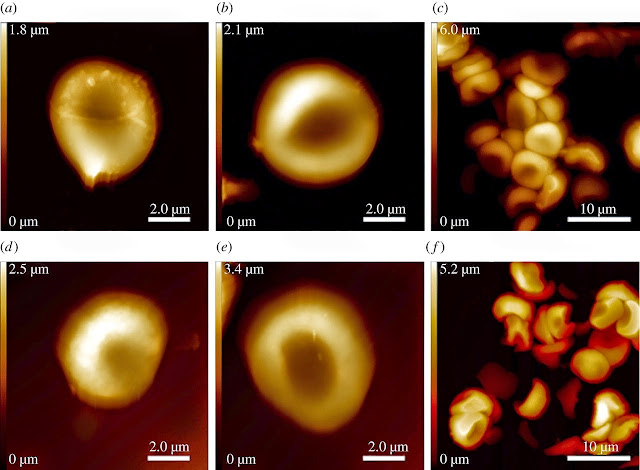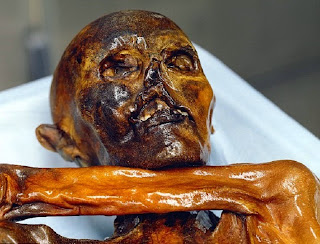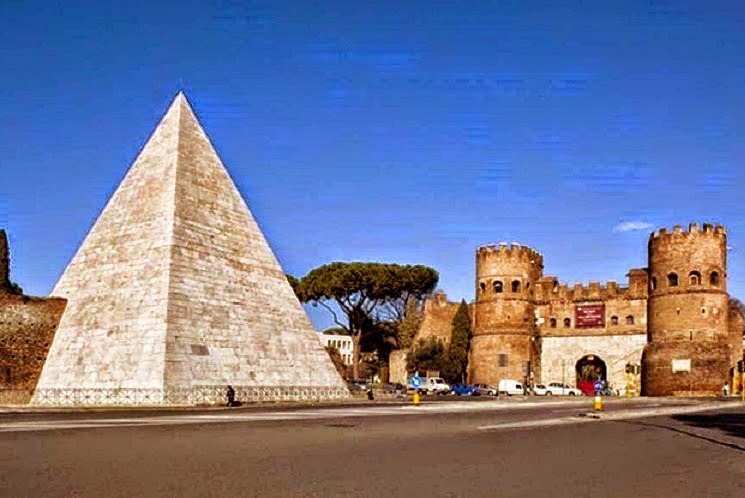- Due ferite: una di freccia e l'altra un taglio sulla mano destra. Sono state esaminate con una sonda nanotecnologica avanzatissima, che ha identificato con laser-scanner la tipica forma a concavità doppia dei globuli rossi...
- Il sangue umano in oggetto è il più antico mai trovato (5.300 anni fa circa) con certezza (altri reperti dell'età della pietra, su strumenti ed altro, non sono certi, in quanto varie altre entità possiedono forme analoghe al globulo rosso: grani di polline, batteri etc e con esso potrebbero essere state confuse).
- La certezza. In questo caso, la rifrazione della luce del laser ha permesso di identificare con precisione una proteina tipica ed esclusiva del globulo rosso (emoglobina) ed una sostanza coagulante (fibrina.)
- Si tratta di un omicidio di 5.000 anni fa, per cause sconosciute: un uomo fu ucciso da una freccia scagliata con l'arco. Il caso di Iceman Otzi è un vero 'cold case' e s'indaga ancora...
- La sua morte fu rapida dopo neanche qualche minuto; se fu dolorosa, ebbene: non soffrì a lungo. Questo si può affermare proprio per via della presenza della fibrina: quest'ultima si forma immediatamente, subito dopo la lesione. In un corpo vivo, però, scompare e viene riassorbita dopo pochi minuti.
- L'articolo dell'avanzatissima indagine è comparso sulla rivista Interface, autore Albert Zink, capo dell'Istituto per le mummie e per l'Icemen, di Bolzano, Italia.
World's oldest blood found
in famed
"Iceman" mummy
The world's oldest known blood cells have been found on Ötzi the Iceman, according to the latest research on the 5,300-year-old mummy.
What's more, the discovery proves that the Stone Age homicide victim had a quick, if not painless, death.
AFM images of red blood cells (RBCs).
(a,b) Single RBCs from recent human tissue. (c) An assembly of RBCs. (d,e) Single corpuscles found in Iceman sample A and sample B are shown. An assembly of several randomly distributed corpuscles, similar to those found within the recent sample (c), are displayed in image (f). The imaged corpuscles (d–f) feature the characteristic discoid and concave surface of RBCs
[Credit: Journal of the Royal Society Interface]
Ötzi has been the subject of extensive postmortem investigations ever since his corpse was discovered in an Alpine glacier on the Austrian-Italian border in 1991.
No blood residue had previously been detected, however, despite various studies detailing his violent death due to an arrow shot and other injuries.
"There were no [blood] traces found, even when they opened some arteries, so it was thought maybe the blood had not preserved and had completely degraded, or that he lost too much blood because of the arrow injury" on his back, said team member Albert Zink, head of the Institute for Mummies and the Iceman in Bolzano, Italy.
For the new investigation, scientists traced Ötzi's wound areas—the arrow injury and a cut on his right hand—with a pioneering nano-size probe.
Each minute movement of the probe was recorded with a laser, "so you get a three-dimensional image of the sample in a very tiny scale," Zink explained. The scans revealed classic "doughnut shape" red blood cells, the team reported Wednesday in the journal Interface.
While past studies have suggested evidence for prehistoric blood on Stone Age tools and other artifacts, "you can never really be sure, because you can see structures which are quite similar to red blood cells" such as pollen grains or bacteria, Zink commented.
Ötzi the Iceman's mummified remains (shown above) were found on a glacier on the Italian and Austrian border in 1991. Researchers have now discovered traces of a molecule involved in blood clotting on the body, suggesting he bled rapidly to death from an arrow wound to his shoulder
[Credit: Reuters]
To confirm they were indeed dealing with human blood cells, the researchers illuminated the wounds with a laser. The wavelengths of the scattered light revealed the substances' molecular makeup.
"We got very typical samples for blood, like for the [blood protein] hemoglobin," he said. The new finding "really is the oldest clear evidence for red blood cells.
" The new nanotechnology, allied with an atomic force microscope, also uncovered traces of fibrin, a blood-clotting agent—evidence that the Iceman suffered a mercifully quick demise.
"Fibrin is formed immediately when you get a wound, within a few minutes, but then it disappears"—in a living, functioning body, anyway, Zink said.
"Finding fibrin in the arrow wound is confirmation that Ötzi actually died very quickly after the arrowshot."
"There were still some people arguing that he survived the arrow maybe a few hours or a few days, but this was definitely not true," he added.
The relatively new techniques used in the study may in the future assist in the investigation of modern-day homicides. Since old blood cells are more elastic than fresh samples, the same blood-analysis techniques could become useful at crime scenes, Zink said. "If the blood is dry, forensic science really has no good method for determining the age of blood spots ... They cannot say if it is a day, a week, or a month old," he said. "If you can record with this technology little differences in the elasticity of the structure, then you can maybe determine the age of the blood spot."
Author: James Owen | Source: National Geographic News
[May 08, 2015]


















